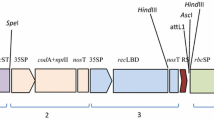Abstract
The hybrid Bacillus thuringiensis (Bt) δ-endotoxin gene Cry1Ab/Ac was used to develop a transgenic Bt rice (Oryza sativa L.) targeting lepidopteran insects of rice. Here, we show the production of a marker-free and tissue-specific expressing transgenic Bt rice line L24 using Agrobacterium-mediated transformation and a chemically regulated, Cre/loxP-mediated DNA recombination system. L24 carries a single copy of marker-free T-DNA that contains the Cry1Ab/Ac gene driven by a maize phosphoenolpyruvate carboxylase (PEPC) gene promoter. The marker-free T-DNA was integrated into the 3′ untranslated region of rice gene Os01g0154500 on the short arm of chromosome 1. Compared to the constitutive and non-specific expression of the P Actin1 :Cry1Ab/Ac:T Nos gene in the control Bt rice line T51-1, the P Pepc :Cry1Ab/Ac:T Nos gene was detected only in the leaf and stem tissues of L24. More importantly, compared to high levels of CRY1Ab/Ac proteins accumulated in T51-1 seeds, the CRY1Ab/Ac proteins were not detectable in L24 seeds by Western blot analysis. As demonstrated by insect bioassay, L24 provided similar level of resistance to rice leaffolder (Cnaphalocrocis medinalis) as T51-1. The marker-free transgenic line L24 can be used directly in rice breeding for insect resistance to lepidopteran insects where absence of Bt toxin protein in the seed is highly desirable.







Similar content being viewed by others
References
Bradford M (1976) A rapid and sensitive method for the quantitation of microgram quantities of protein utilizing the principle of protein–dye binding. Anal Biochem 72:248–254
Cheng X, Sardana R, Kaplan H, Altosaar I (1998) Agrobacterium-transformed rice plants expressing synthetic cryIA (b) and cryIA (c) genes are highly toxic to striped stem borer and yellow stem borer. Proc Natl Acad Sci USA 95:2767–2772
Chestukhina G, Kostina L, Mikhailova A, Tyurin S, Klepikova F, Stepanov V (1982) The main features of Bacillus thuringiensis-endotoxin molecular structure. Arch Microbiol 132:159–162
Christou P, Capell T, Kohli A, Gatehouse J, Gatehouse A (2006) Recent developments and future prospects in insect pest control in transgenic crops. Trends Plant Sci 11:302–308
Datta K, Vasquez A, Tu J, Torrizo L, Alam M, Oliva N, Abrigo E, Khush G, Datta S (1998) Constitutive and tissue-specific differential expression of the cryIA(b) gene in transgenic rice plants conferring resistance to rice insect pest. Theor Appl Genet 97:20–30
de Maagd R, Bravo A, Crickmore N (2001) How Bacillus thuringiensis has evolved specific toxins to colonize the insect world. Trends Genet 17:193–199
Ghasimi Hagh Z, Rahnama H, Panahandeh J, Baghban Kohneh Rouz B, Arab Jafari K, Mahna N (2009) Green-tissue-specific, C 4-PEPC-promoter-driven expression of Cry1Ab makes transgenic potato plants resistant to tuber moth (Phthorimaeaoperculella, Zeller). Plant Cell Rep 28:1869–1879
Keese P (2008) Risks from GMOs due to horizontal gene transfer. Environ Biosafety Res 7:123–149
Koziel M, Beland G, Bowman C, Carozzi N, Crenshaw R, Crossland L, Dawson J, Desai N, Hill M, Kadwell S (1993) Field performance of elite transgenic maize plants expressing an insecticidal protein derived from Bacillus thuringiensis. Nat Biotech 11:194–200
Liu Y, Mitsukawa N, Oosumi T, Whittier R (1995) Efficient isolation and mapping of Arabidopsis thaliana T-DNA insert junctions by thermal asymmetric interlaced PCR. Plant J 8:457–463
Matsuoka M, Minami E (1989) Complete structure of the gene for phosphoenolpyruvate carboxylase from maize. Eur J Biochem 181:593–598
Nayak et al (1997) Transgenic elite indica rice plants expressing CryIAc delta-endotoxin of Bacillus thuringiensis are resistant against yellow stem borer (Scirpophaga incertulas). Proc Natl Acad Sci USA 94:2111–2116
Pathak M, Khan Z (1994) Insect pests of rice. International Rice Research Institute, Los Banos
Romeis J, Meissle M, Bigler F (2006) Transgenic crops expressing Bacillus thuringiensis toxins and biological control. Nat Biotech 24:63–71
Sambrook J, Fritsch EF, Maniatis T (1989) Molecular cloning: a laboratory manual, 2nd edn. Cold Spring Harbor Laboratory Press, Cold Spring Harbor
Schnepf E, Crickmore N, Van Rie J, Lereclus D, Baum J, Feitelson J, Zeigler D, Dean D (1998) Bacillus thuringiensis and its pesticidal crystal proteins. Microbiol Mol Biol Rev 62:775
Sreekala C, Wu L, Gu K, Wang D, Tian D, Yin Z (2005) Excision of a selectable marker in transgenic rice (Oryza sativa L.) using a chemically regulated Cre/loxP system. Plant Cell Rep 24:86–94
Sternberg N, Hamilton D, Hoess R (1981) Bacteriophage P1 site-specific recombination. II. Recombination between loxP and the bacterial chromosome. J Mol Biol 150:487–507
Tu J, Zhang G, Datta K, Xu C, He Y, Zhang Q, Khush G, Datta S (2000) Field performance of transgenic elite commercial hybrid rice expressing Bacillus thuringiensis delta-endotoxin. Nat Biotech 18:1101–1104
Usuda K, Wada Y, Ishimaru Y, Kobayashi T, Takahashi M, Nakanishi H, Nagato Y, Mori S, Nishizawa N (2008) Genetically engineered rice containing larger amounts of nicotianamine to enhance the antihypertensive effect. Plant Biotechnol J 7:87–95
Yin Z, Wang G (2000) Evidence of multiple complex patterns of T-DNA integration into the rice genome. Theor Appl Genet 100:461–470
Zuo J, Niu Q, Chua N (2000) An estrogen receptor-based transactivator XVE mediates highly inducible gene expression in transgenic plants. Plant J 24:265–273
Zuo J, Niu Q, Moler S, Chua N (2001) Chemical-regulated, site-specific DNA excision in transgenic plants. Nat Biotech 19:157–161
Acknowledgments
The authors thank Yunlu Fan for providing plasmid pFWZ16 and Qifa Zhang for providing Bt line T51-1. This work was supported by intramural research funds from Temasek Life Sciences Laboratory (Z.Y.). The authors declare that they have no conflict of interest.
Author information
Authors and Affiliations
Corresponding author
Additional information
Communicated by K. Chong.
C. Qiu and J. S. Sangha contributed equally to this work and their last names appear in alphabetical order.
Rights and permissions
About this article
Cite this article
Qiu, C., Sangha, J.S., Song, F. et al. Production of marker-free transgenic rice expressing tissue-specific Bt gene. Plant Cell Rep 29, 1097–1107 (2010). https://doi.org/10.1007/s00299-010-0893-x
Received:
Revised:
Accepted:
Published:
Issue Date:
DOI: https://doi.org/10.1007/s00299-010-0893-x




